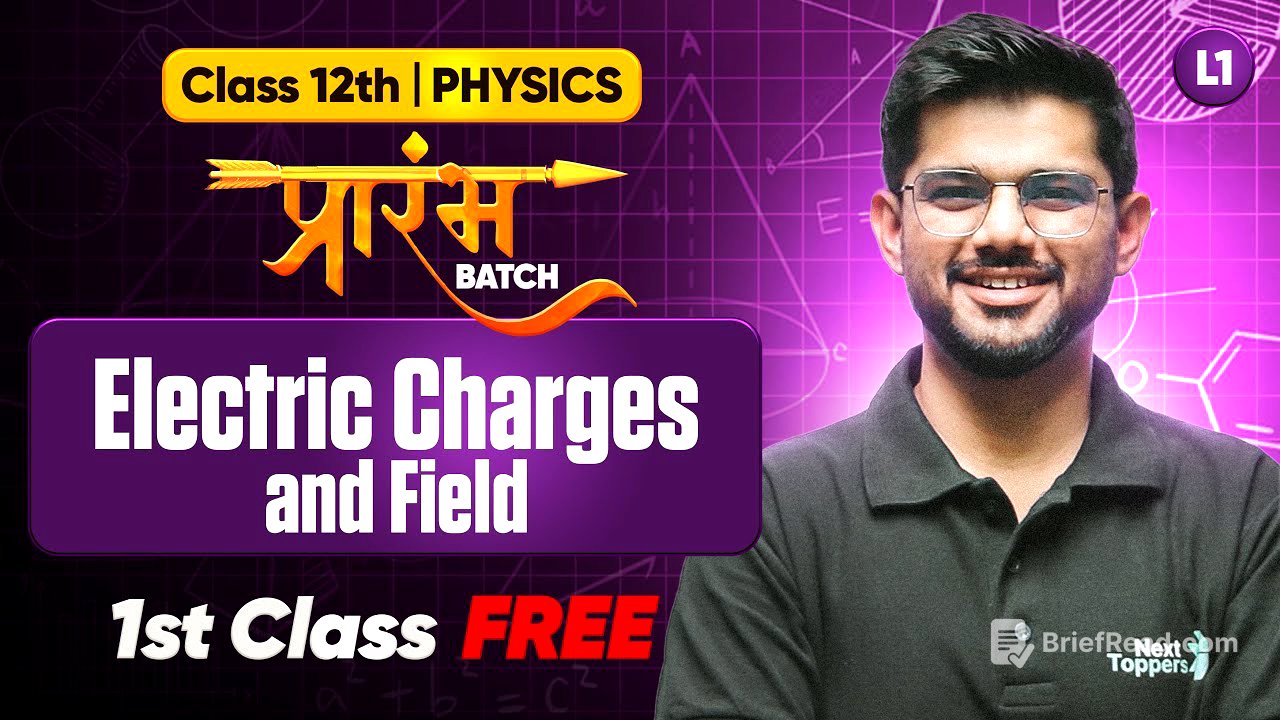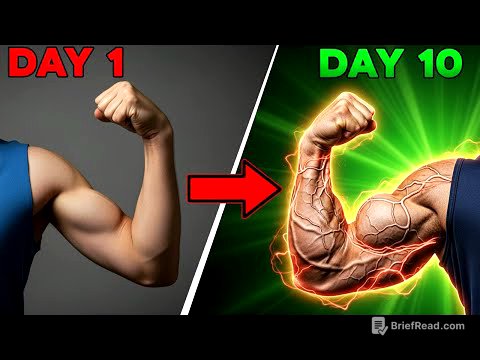TLDR;
This YouTube video serves as an introductory class for 12th-grade physics, focusing on electric charges and fields. The instructor outlines the course's scope, emphasizing conceptual understanding and problem-solving skills. Key points covered include the origin and properties of electric charge, comparison of charge and mass, methods of charging objects, and the use of the Gold Leaf Electroscope. The session aims to build a strong foundation for understanding electromagnetism and prepares students for tackling complex problems.
- Origin and properties of electric charge
- Comparison of charge and mass
- Methods of charging objects
- Gold Leaf Electroscope
Introduction and Course Overview [0:00]
The instructor welcomes students to the 12th-grade physics course, emphasizing that the course will cover all boards that align with the NCERT syllabus. The instructor assures students that the course will start from a basic level, even covering concepts from 11th grade that are relevant to 12th-grade physics. The instructor highlights the importance of enthusiasm and passion for the subject, promising to support students from the beginning to the end of their exams. The instructor also gives a reality check, stating that the CBSE papers are becoming increasingly conceptual and challenging.
Electrostatics and Electrodynamics [13:26]
The instructor provides an overview of Book One Physics, dividing it into electrostatics and electrodynamics. Electrostatics deals with charges at rest and includes chapters on electric charges and fields, as well as electrostatic potential and capacitance. Electrodynamics covers charges in motion and forms the basis of electromagnetism, which constitutes a large part of the 12th-grade physics curriculum. Electrostatics is defined as the branch of physics studying electric charges at rest and related phenomena.
Origin of Electric Charge [15:01]
The discussion begins with the historical context of electric charge, referencing the observations of the ancient Greeks with amber. It is explained that rubbing amber with wool or silk creates an electric property that attracts pieces of paper. The actual origin of electric charge is attributed to the charged particles within an atom: electrons and protons. Electrons carry a negative charge of -1.6 x 10^-19 coulombs, while protons carry an equal but positive charge. Neutrons have no charge. The SI unit of charge is the coulomb (C), and the MLT form of charge is A1T1.
Properties of Electric Charge vs. Mass [23:36]
The lecture transitions to the properties of electric charge, comparing them with the properties of mass. Mass is always positive, while charge can be positive or negative. Mass is an intrinsic property of matter, as is charge. Mass is a scalar quantity, and so is charge. Unlike gravitational force, which is always attractive, electric force can be attractive or repulsive depending on the nature of the charges. Charge cannot exist without mass, but mass can exist with zero net charge. Mass depends on speed, especially at speeds close to the speed of light, whereas the magnitude of charge is independent of speed.
Basic Properties of Electric Charge: Additive Nature [33:43]
The instructor explains the additive nature of electric charge, stating that the net charge on a system is the algebraic sum of all the charges present. For example, in a system with charges of +3, -2, and +10 coulombs, the net charge is +11 coulombs. Similarly, in a system with five electrons and three protons, the net charge is -2e, where e is the elementary charge.
Basic Properties of Electric Charge: Quantization [37:18]
The concept of charge quantization is introduced using the example of rubbing a glass rod with a silk cloth. Electrons transfer from one material to another in integer numbers, resulting in a net charge that is always a multiple of the elementary charge (e). The formula q = ne is presented, where n is an integer. This means charges are transferred in discrete amounts, and fractions of the elementary charge are not observed.
Basic Properties of Electric Charge: Conservation [43:37]
The principle of charge conservation is explained, stating that the net charge in an isolated system remains constant. Using the earlier example of the glass rod and silk cloth, the initial net charge of the system (glass + silk) is zero, and after rubbing, the total charge remains zero, even though the individual objects become charged. This principle is further illustrated with a system of two spheres, where the total charge before and after rubbing remains the same.
Numerical Problems on Charge Quantization [48:47]
The session includes several numerical problems to illustrate the application of charge quantization. One problem involves calculating the charge acquired by a neutral body after injecting 10^20 electrons, resulting in a positive charge of 16 coulombs. Another problem asks how many electrons must be removed from a body to electrify it with a charge of 6.4 coulombs, with the solution being 4 x 10^19 electrons. A multiple-choice question is presented, asking for the net charge on an object that initially has a charge of 1 coulomb and gains 5 x 10^18 electrons, with the correct answer being +0.2 coulombs.
Conductors and Insulators [57:10]
The discussion shifts to conductors and insulators, explaining that conductors have free electrons that allow electricity to pass through them easily, while insulators have very few free electrons. In conductors, the outer electrons of each atom are weakly bound, allowing them to move freely within the lattice structure. When a charge is transferred to a conductor, it distributes radially over the entire surface. In contrast, insulators have tightly bound electrons, and any charge given to them remains localized on the surface where it was applied.
Methods of Charging: Friction [1:02:44]
The lecture covers three methods of charging objects: friction, conduction, and induction. Charging by friction involves rubbing two insulating materials together, causing electrons to transfer from one material to the other. For example, rubbing a silk cloth with a glass rod results in the glass rod becoming positively charged and the silk cloth becoming negatively charged. The mass of the silk cloth increases due to the addition of electrons, while the mass of the glass rod decreases.
Methods of Charging: Conduction [1:07:10]
Charging by conduction involves bringing a charged object into contact with a neutral conductor, allowing charge to flow from one to the other. The instructor presents a formula for calculating the final charge on two identical spheres after they are connected with a wire: q_final = (q1 + q2) / 2. The reason for charge flow is attributed to the potential difference between the objects. Numerical problems are presented to illustrate this concept, including scenarios with different initial charges on the spheres.
Methods of Charging: Induction [1:18:54]
Charging by induction involves bringing a charged object near a neutral conductor without direct contact, causing a redistribution of charges within the conductor. The process involves several steps: bringing the charged object close, redistributing charges, earthing or bringing another conductor nearby, and separating the objects to create a net charge. The instructor emphasizes that understanding the concept is more important than memorizing the steps.
Attraction and Repulsion Between Charged and Neutral Bodies [1:24:12]
The session addresses whether a charged body can attract or repel a neutral body. It is explained that a charged body can attract a neutral body due to the induction effect, where charges redistribute within the neutral body, creating an attractive force. However, repulsion cannot occur between a charged body and a neutral body. Repulsion is the true test for identifying whether a body has an electric charge. A challenging question is presented, involving a negatively charged object repelling another object and attracting a third object, requiring students to apply their understanding of these concepts.
Gold Leaf Electroscope [1:31:31]
The Gold Leaf Electroscope is introduced as an instrument used to detect the presence of charge on a body. The electroscope consists of a brass rod, a brass disc, an insulator plug, and gold leaves. When a charged object is brought near the disc, the charge is distributed to the gold leaves, causing them to repel each other and indicating the presence of charge. The instructor explains the mechanism of the electroscope for both positively and negatively charged objects.
Session Summary and Homework [1:35:44]
The instructor summarizes the topics covered in the session, including the origin and properties of charge, comparison of charge and mass, methods of charging, and the Gold Leaf Electroscope. Students are advised to make good notes and revise the concepts. Homework questions are assigned, and students are directed to the Next Topper app for notes and assignments. The session concludes with encouragement and a preview of the next session, which will cover Coulomb's Law.








